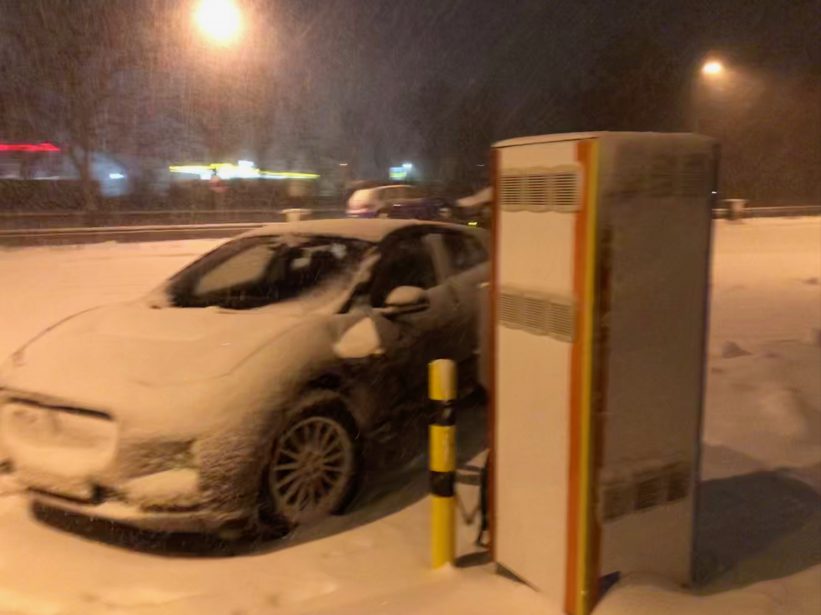By Roland Steinmetz
Driving a 100% electric car is always great fun, because of acceleration, quiet driving and the idea you are not burning fossil fuel. My brand new Jaguar I-pace is a solid and excellent car that can drive around 330km on a single charge in wintertime on the highway. So you can imagine the summer range would be about 400km. Last week, we took electric driving to the next level. For fun, and to test what drivers of EV’s may face when they go beyond their normal day to day driving routine.
For our EVConsult ski trip I took the I-pace to Austria and it was an exciting adventure! In any case because there was a snow storm in the south of Germany and Austria at the time and almost half of the route it was indeed snowing. The circumstances were challenging for any car, but luckily the i-pace offers the advantage of having a 4 wheel drive.
If you are planning to take your electric vehicle off the beaten track, you might find these 9 lessons we’ve learned very helpful…
1. Adopt the mindset of a pioneer. Although I have been driving electric for almost 8 years, a 1000km trip in a brand new model is pioneering. You come across all kinds of insecurities before and during the trip: is the driving efficiency as expected? What happens with traffic jams and detours? Is the charger at the expected location, will the charger work and how long will it take? It was an excellent playground for EV lovers like me. It may be different for Tesla drivers though, where chargers, route planning and interoperability is not an issue.
2. Take a co-pilot. The route might have been planned, it is still useful to monitor progress, check online if chargers are occupied and find alternatives. And of course, it’s a lot more fun traveling together !
3. Plan your route in detail. I mainly used A better routeplanner for the route. A lot of variables can be indicated and used for different scenarios. We checked every individual charger on Going Electric to see if we could get access to the charger with our charging pass from Jaguar and NewMotion. Off course we planned to use as many 150kW chargers as possible to make use of the maximum of 80kW charging capacity. There is an abundance of 50 kW chargers on this route, so in principle charging shouldn’t be a problem.
4. Monitor range & speed. The route plan indicated maximum driving speeds on the highway but sometimes the actual consumption appeared to be different. So, we regularly checked Google Maps for the distance to the planned chargers (for instance 220 km) and the range of the car (for instance 240 km). The delta between the two (20km) was carefully managed by the co-pilot to make sure we kept a bit of spare range and drive according to plan.
5. Use an app to find the exact location of the charging station. The chargers are mostly hidden behind at least 2 or three petrol stations and difficult to find in the dark. Sometimes far away from decent facilities and even behind a hydrogen station, what a disgrace J. It’s a shame the charging stations are not on the first and most premium location. More work to be done for us at EVConsult!
6. Bring along various cards as identification methods. In Germany the Jaguar app worked well on most of the chargers but not on all. Sometimes we used the RFID card or the CPO app (like Fastned and Innogy). The credit card option was often disabled or not functioning on the German chargers. Interoperability is still a major issue for a seamless charging experience. Our preference was the Auto charge solution where it’s just a matter of plugging in and charging starts automatically.
7. Take into account that not all chargers are reliable. The I-pace is a very new car and not all charger software has been updated (or vehicle software). In our experience some brands were much more reliable than others however. We have tested the CPO’s Innogy, E.ON, Allego, Fastned and ENBW.
8. Our average consumption was around 0,27 kWh/km. We drove about 100-110 km/h and often slower because of heavy snow. The heating was always on and driving in ECO mode. On the last part we used the extreme efficient mode. By planning properly and adjusting to real circumstances as you go along you can come a long way but it takes additional time.
9. The way home is way smoother. This first trip to Austria already delivered loads of insights. So when we returned back to Amsterdam we made it very simple, we wanted to be as fast as possible (150kW) and as reliable as possible with regard to charging. We diverted the route to have 4 stops of 45 minutes at chargers we were confident that worked.
Now we understand the Fastned high yellow canopy even better, you can see it from long distance and keeps you dry while plugging in.
This ski-trip with an electric car is a bit different from driving a diesel for 1000km. But when you think about the fact that a 80 liter diesel tank has high energy density because it uses compressed plant material of about 150 million years old and burns it in a matter of hours it really changes your perspective, at least in my case. I really enjoy driving the I-pace, and the funny thing is, after this adventure any trip around Netherlands is a piece of cake!

